Media in Pakistan continues to face grave threats, including threats to the lives of journalists. The recent statistics are stark. Over 60 journalists have been killed in the last six years (2007 to 2013) – about two-thirds of them shot dead in target killings and the rest killed in suicide attacks and bombings in public places. On average, for each journalist killed there are over a dozen that face intimidation, harassment and even assault and injuries. For the past five years Pakistan has consistently ranked among the top 5 worst countries for working journalists. The killer of not even one of these journalists has been identified or punished.
The principal challenge before journalists in Pakistan is combating this impunity – helping themselves get justice by invoking a legal course to identify, nab, prosecute and punish attackers. While the state is failing in its duty to investigate, identify and chase down attacks of media practitioners, sadly the journalist community has also not prioritized using the legal mechanisms as a specific defense measure against the increasing attacks on them. While hard data is hard to come by, representative associations of journalists say FIRs [first information reports filed with police] are few and far between and actual cases filed and pursued in courts fewer still as most journalists killed are not full-time contracted employees of media houses which then don’t feel it is their responsibility to get justice for the slain journalists.
Not only have the increasing violence and terrorism in the country of the past few years affected Pakistani journalists adversely, the political and democratic transition spanning the same period have also contributed to their uncertainties and security concerns. This is because media freedoms, the right to free speech and the right to information have themselves been issues of debate in this period for which the journalists have had to struggle and sustain losses.
Though Pakistan guarantees the right to free speech in its constitution under Article 19 and access to information under Article 19A and is a signatory to all relevant international covenants, these rights have been under severe threat for some years as journalists have been killed for their reporting of not just terrorism but also politics.
The threats faced which Pakistani journalists have included killings, disappearances, torture, kidnapping, physical assault, verbal intimidation and threats of reprisals. The trend has been in effect since 2000 but accelerated around 2006 after which the staggering average at which journalists have been killed in Pakistan is one every month. There have been cases of journalists and media houses being charged with criminal offences, including terrorism. A number of media establishments have been targeted with attacks on their buildings and staff. One of the overall effects of this has been indirect and even direct censorship, including those ordered by the courts while self-censorship by media practitioners is rampart, especially in areas riven by various conflicts and terrorism.
So, how do the Pakistani journalists and media get their act together and fight back? [box type=”info” ]There is a new development that offers a broader solution to combating this impunity against journalists in Pakistan. [/box]The UN Plan of Action on impunity against journalists – which names Pakistan as one of the five pilot countries for implementation – offers a bright ray of hope in the battle for safety of working journalists. This is because the UN Plan of Action not only identifies measures and mechanisms by means of which this fight can be fought along organized lines but also offers detailed Journalists Safety Indicators (JSI), which allow for a detailed mapping of the state of impunity and several proposed actions, measures and alliances that can be pressed into action. The UN Plan of Action also proposes focused collaboration amongst pre-identified key stakeholders and identification of resources and support for them to help the journalists start fighting back against threats to them in an organized, systematical manner.
As for what’s ahead for Pakistani journalists – this depends on how Pakistan as a state tackles the several conflict fault-lines it is grappling with – from religious extremism to terrorism and from militants and outlaws to weak state apparatus that in some ways actually contributes to the threats against journalists. Reporting in such an environment is extremely risky and with the absence of agreed mechanisms among stakeholders on minimizing risks, building capacity of journalists to stay safe and promoting professional ethics as a tool to thwart attacks and minimize risks, the immediate future for Pakistani media doesn’t seem like improving anytime soon.
While external factors such as destabilization of the state and violence in the country will remain a key threat to media practitioners in Pakistan, it is primarily up to journalists, their representative associations and media houses to improve their own security and safety. Fortunately, partly in response to the UN Action Plan naming Pakistan as a pilot country for implementation, a new alliance has recently been formed – the Pakistan Coalition on Media Safety (PCOMS) – that offers a ray of hope for the journalists in the country. To be peopled by representative associations of media owners, media workers, media support organizations, parliamentarians and government functionaries, PCOMS is mandated to draft a national charter on media safety and to identify priorities and mechanisms for collaborative implementation to battle impunity, reduce the framework of risks and to keep the journalists safer. How effective and successful PCOMS is will be clear in the coming months.
______________________________________________________________________
Adnan Rehmat is a media analyst and media development specialist. He can be reached on: adrehmat@gmail.com
______________________________________________________________________
Combating Impunity of Crimes Against Media in Pakistan
- September 5, 2013
- 12:31 pm
- No Comments
More from the News section
September 18, 2023
No Comments
July 26, 2023
No Comments
June 20, 2023
2 Comments
March 21, 2023
No Comments
August 30, 2022
No Comments
Resize text-+=

